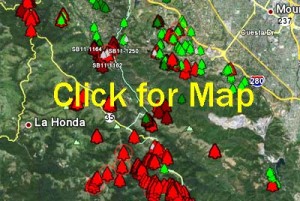Based on the study published by the UC Berkeley Garbelotto lab in California Agriculture (http://nature.berkeley.edu/garbelotto/downloads/calag2009.pdf), azomite and/or lime washes alone are not effective in controlling SOD.
While phosphonate injections to help control SOD are now recommended once every 2 years, spray applications should still be applied to the bark of oak trees annually.
The stems of poison oak plants can be infected by Phytophthora ramorum (the plant pathogen known to cause SOD); however, we do not know if leaves can be.
The stems of poison oak plants can be infected by Phytophthora ramorum (the plant pathogen known to cause SOD); however, we do not know if leaves can be.
Once bark beetles attack the main stem (trunk) of an oak, the tree is on its way out. Insecticide treatments will not save it. Oak beetles are attracted to trees that are severely compromised. They cannot attack healthy trees.
The correct approach to avoid bark beetle infestations is not to apply insecticides, but rather to identify any health issues a tree may have. As of October 2015, many trees are suffering from the prolonged drought and may need watering. Watering should be applied infrequently and never during the summer. Water-starved trees may display a thinner crown, with olive-green rather than dark-green leaves. Leaves may also be crisp when folded between your fingers. If you opt to provide water to an oak tree that is severely water deprived, make sure the water reaches a depth of about one foot below the soil surface. Also make sure the flow is low to avoid flooding the base of the tree.
The symptoms on your oak may be caused by a range of issues. If oozing is accompanied by the presence of fine sawdust, then the tree is dying. Even if it is still green you may want to consider removing it if its failure may cause harm to people or property. The fine sawdust is caused by beetles tunneling in the tree. Oaks are only attacked by beetles when dying. If no sawdust is present, then the tree’s condition may be reversible.
Unfortunately, it is difficult to determine what may be the cause of the symptoms you describe. Sudden Oak Death (SOD) can attack an oak tree if California bay laurel is within 60 feet of the oak. You can use the free SODmap Mobile App to determine if you are in a high or moderate risk zone for SOD. To find out how to do that, go to www.sodmapmobile.org. There is also a YouTube video you can watch at https://youtu.be/zE0_q3EmIfs. If the information you gather suggests that it may be SOD, then repeat the phosphite bark application (such as Agri-Fos® combined with Pentra-Bark®) in the fall between October 30th and December 15th. You may also want to consider removal of bays within 30 feet from the oak. Go to http://nature.berkeley.edu/garbelottowp/?page_id=909 to find out about upcoming treatment training sessions to learn more about treatment options. If there are no bays within 60 feet of your oak and the SODmap mobile risk is low, then it likely isn’t SOD.
If you have watered your oak, it may be a root disease such as the oak root fungus or Phytophthora cinnamomi root disease. Make sure you stop watering and expose the upper root system to the air to slow disease progression. If you have never watered your oak, then it may be a secondary disease brought on by the long drought (ex. oak die-back fungus). These are diseases that are strongly affected by the genetics of the tree and weather conditions. In this case, you may want to try watering the tree now and then once again in 2 weeks. Then water once a month starting October 15th. Do not water between July 10th and October 15th. Watering should be done using a low flow approach to ensure that the soil gets wet up to 1 foot down and that no flooding of the tree ever occurs. Unfortunately, if the secondary disease is too advanced, despite all efforts, the tree may still die.
The revised SOD treatment recommendations can be found at: https://nature.berkeley.edu/garbelottowp/?p=1039.
Once an oak has the oak root fungus Armillaria (often due to excessive watering), most treatments will be ineffective. Be sure the base of the tree is free of mulch and other organic debris and slightly expose the root system at the root collar. While fertilizing may not help, try using one bark application of Agri-Fos + PentraBark. This application provides minimum nutrients, but strengthens the defense mechanisms of the tree. Of course, stop watering unless absolutely necessary. Water should never be administered from July-September.
It sounds like your tree is having problems providing enough water to the canopy to keep the foliage and cambium alive. If you are not watering it, that may be the problem. If you are watering it, your tree may have contracted a root disease. In that case, it is important to clear all organic material at least 3 feet around the stem, slightly expose the root system next to the stump to the air, avoid fertilizers, and water minimally.
Download sod map mobile and tap the risk button. If the risk shows up as high or moderate, call an arborist listed at http://www.suddenoakdeath.org/diagnosis-and-management/arborists-applicators/. If you get an insufficient data response, then see if you have any CA bay laurel trees within 20 yards of the oak. If you find any, do they have possible P. ramorum (pathogen that causes sudden oak death) symptoms (symptomatic photos: http://www.suddenoakdeath.org/library/photos/plant-symptom-photos/; host information: http://www.suddenoakdeath.org/diagnosis-and-management/hosts-and-symptoms/). If you do find questionable symptoms on bay, again, call an arborist listed at http://www.suddenoakdeath.org/diagnosis-and-management/arborists-applicators/ for a site visit.








